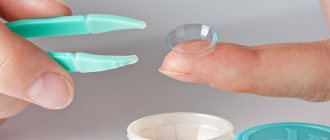Features of soft contact lenses for planned replacement
Traditional soft contact lenses are used as long as they provide adequate vision correction and comfort, i.e. approximately 12 months. Planned and replacement contact lenses are lenses that must be replaced after 1 or 3 months of use. Frequently scheduled replacement or disposable contact lenses are considered to be contact lenses that are subject to replacement, in accordance with the manufacturer's recommendation, after 1 day, 1 or 2 weeks.
Although the same materials are required to make disposable contact lenses and traditional soft contact lenses, disposable contact lens manufacturing processes are more complex and advanced because they allow for faster and cheaper high-volume contact lens production. This allows you to significantly reduce the cost of contact lenses while maintaining high accuracy and reproducibility of parameters and makes successful regular replacement of contact lenses possible. In the 1980s and early 1990s, elective replacement contact lenses had a very limited range of options and designs. Over the past five years, the situation has changed significantly, and today large and small manufacturers produce scheduled replacement contact lenses of various radii of curvature, designs (spherical, toric, multifocal), refractive ranges, thicknesses, diameters, not to mention additional features - coloring and UV- protection. Expanding the parameters of elective replacement contact lenses allows contactologists to more successfully prescribe them to patients, achieving optimal correction and healthier eye condition.
Types of contact lenses depending on wearing mode
The wearing mode determines the maximum permissible duration of wearing lenses without interruption for disinfection.
The following wearing modes are distinguished:
1) Daytime; 2) Flexible; 3) Prolonged; 4) Continuous wearing.
Day mode
Daytime wearing allows contact lenses to be used during the day, followed by their removal and disinfection. Wearing duration is from 10 to 12 hours. The packaging of contact lenses of this type is marked DW.
Flexible mode
Flexible wearing sometimes allows the patient to sleep in the lenses, but it is not advisable to repeat this for more than three nights in a row. The FW mark indicates that the lenses belong to this type.
Extended Mode
Extended wear lenses allow the patient to wear them continuously for a week. After 7 days you need to take a break. Manufacturers leave the EX mark on the packaging of such lenses.
Continuous wearing
Continuous wear lenses can be worn without interruption for a month (that is, not removed for disinfection). The possibility of wearing them for a long time is due to the material, which allows oxygen to pass through well. Manufacturers leave the CW mark on the packaging of such lenses.
You may be interested in How to choose colored lenses for brown eyes
Using lenses in excess of the permissible norm may cause the patient to experience a number of unpleasant symptoms, such as itching, redness, inflammation of the eyes or dryness. This is due to the fact that when the permissible time is exceeded, the level of moisture decreases, the lenses transmit oxygen worse and become less resistant to dirt.
Benefits of Planned Replacement
Let us recall the main advantages of frequent replacement of contact lenses. 1. Replacing your contact lenses at regular, short intervals reduces the chance of accumulation of residue from tears and chemicals used in contact lens care products, and therefore promotes healthier eyes. It is known that the light transmission of contact lenses is determined by the cleanliness of the surfaces and the stability of the tear film under the contact lens, and sediments on the surface of contact lenses contribute to their hydrophobization and uneven wetting.
2. Frequent replacement of contact lenses reduces the likelihood of wearing damaged contact lenses. If the patient discovers that the contact lens has become unusable, he can immediately replace it with a new one. In the case of using traditional contact lenses, the patient, until his order is completed, is forced to use a damaged contact lens for some time, which can cause eye irritation and mechanical damage to the cornea.
3. More frequent replacement of contact lenses simplifies the procedure for caring for them. Contact lenses that are frequently replaced regularly do not require enzyme cleaning at all, and multi-purpose solutions can be used to clean and disinfect contact lenses after removal. Daily replacement contact lenses require no maintenance at all.
4. Long-term storage of contact lenses increases the risk of contamination by microorganisms, so the routine replacement regimen is more suitable for those patients who use contact lenses from time to time.
5. The mode of frequent scheduled replacement is extremely convenient for those going on a trip or business trip, since there is no need for numerous bottles of solutions. Significantly fewer problems arise in the event of loss of contact lenses, especially if the patient leaves for an area where it is difficult to obtain the necessary ophthalmological care.
Contact lenses for routine and frequent replacement, taking into account the above benefits of wearing them, can be recommended to any patient, but in some cases their use is especially desirable. First of all, this applies to patients: 1) who have a tendency to rapidly accumulate sediment from tear fluid, as well as those who have suffered complications as a result of this (for example, giant cell conjunctivitis); 2) those who often lose or tear their contact lenses; 3) who use contact lenses from time to time; 4) working in conditions of increased air dust, as well as with harmful chemicals.
Problems with using elective contact lenses
Firstly, in most cases, foreign publications note, the patient’s annual expenses when using scheduled replacement contact lenses and frequently scheduled replacement contact lenses are higher than when wearing regular contact lenses. Of course, specialists explain to patients that they are not just purchasing more contact lenses, but also paying for the benefits of this wearing regimen.
Second, in an effort to reduce costs, some patients wear routine replacement contact lenses for longer periods than recommended by manufacturers and contact doctors. However, keep in mind that routine replacement contact lenses and frequent replacement contact lenses are not designed for long-term use, so they become damaged more quickly and may accumulate tear deposits more quickly.
Thirdly, many patients who use routine replacement contact lenses and frequent replacement contact lenses neglect the rules of caring for them. Contact lenses must be cleaned after each removal.
Fourth, elective replacement contact lenses are typically thinner than regular contact lenses, making them more difficult to handle, especially for first-time patients.
Compliance with routine contact lens replacement schedules
From the very beginning of the introduction of elective contact lenses on the market, experts have expressed concerns about the compliance of users with replacement periods. Unfortunately, notes the editor of the magazine Contact Lens Spectrum (2001. No. 6), Mr. Barr, patients often use soft contact lenses for routine replacement much longer than recommended by doctors, manufacturers and guidelines from health authorities. Unlike cotton swabs for cleaning ears, Mr. Burr points out, the patient cannot determine for himself that a contact lens needs to be replaced.
Yet the compliance situation in many Western countries is not as bad as some skeptics expected, who argued that after purchasing two six-packs of contact lenses, a patient would be lost for six years. Experts estimate that patients in the United States who wear biweekly contact lenses purchase an average of six packs (36 contact lenses) per year instead of the recommended eight packs (48 contact lenses). Another study found that the rate of frequent replacement contact lens wearers who met their replacement schedules in the United States in 2000 was 54 percent, down slightly from 1999 (59 percent). This is a major concern for manufacturers, not only due to reduced revenue levels, but also due to possible negative consequences for users.
In our country, says Mr. Prosyanyuk, vice-president of RAPSKZ, general director of Concor Firm LLC, 80 to 90 percent of clients wear out contact lenses with frequent scheduled replacement. The reason for this is, on the one hand, the insufficient explanatory work of doctors on the regime of wearing such contact lenses, and on the other hand, people feel sorry for throwing away contact lenses, since they do not have the financial opportunity to change them every 1 to 3 months. It should be noted that the results of a survey of doctors in St. Petersburg and a number of other large industrial cities gave slightly lower figures - contact lenses are used beyond the specified period by 10 to 50 percent of patients. Thus, according to Samara, the ratio between users of scheduled replacement contact lenses and traditional contact lenses is 4:1, while approximately 40 percent of patients wear contact lenses (surveys were conducted in contact correction rooms).
Marina Pigulevskaya, Veko #7(51)
All about contact lenses
Contact lenses, like glasses or LASIK, can correct almost any degree of nearsightedness, farsightedness and astigmatism. It's a great way to correct vision, healthier and more convenient than ever. Today, contact lenses, if they are correctly selected, are comfortable the first time they are used.
Currently, contact vision correction in Russia is experiencing rapid development. Contact lenses are easy to use and can be an alternative to refractive surgery, which has an irreversible effect and a number of possible complications.
The use of contact lenses gives their users some advantages over the use of spectacle correction only, since the contact lens and the eye form a single optical system, thereby achieving high quality vision. This type of correction is extremely convenient for athletes and other professions where wearing glasses can be not only inconvenient, but also present certain difficulties.
If there is a large difference in vision between the eyes, it is also convenient to use contact lenses, since a large difference in glasses is poorly tolerated and affects the overall comfort when using glasses, sometimes forcing you to abandon them altogether and resort to surgery.
Not many people know that contact correction first appeared in the 16th century. In the literary heritage of Leonardo da Vinci and Descartes, drawings of optical devices were discovered that are prototypes of modern contact lenses.
The first reports of the practical use of contact lenses date back to 1888. And since that time, the process of improving manufacturing technology, materials and the design of lenses has already been actively underway.
The indications for the use of contact lenses have gradually expanded: soft lenses are used not only for the correction of visual impairments, but also for therapeutic purposes in some eye diseases. In addition, it became possible to produce cosmetic, colored, and even carnival lenses.
Currently, many types of contact lenses can be grouped according to certain characteristics and properties:
- The material from which they are made
- Wearing time without removal
- Replacement frequencies for a new pair
- The design and shape of the lens itself
Contact Lens Materials
Depending on the material used, there are three types of contact lenses:
- Soft lenses are the most popular today. They are made from jelly-like hydrogel and silicone hydrogel polymers with a high water content in the lens.
- Rigid gas permeable lenses are made from silicone-based materials and have the highest oxygen permeability. They are especially good for correcting presbyopia and high degrees of astigmatism.
- Hard lenses made of PMMA (plexiglass) are obsolete and practically not used.
In the 80s, the first hydrogel-based soft contact lenses appeared. With the advent of silicone hydrogel materials, soft contact lenses have rightfully gained immense popularity throughout the world because they have high oxygen permeability and are less prone to dehydration of the lens itself.
Contact lens wearing time
In 1979, extended wear lenses were first approved, allowing patients to sleep with their lenses in place for up to 7 days in a row. Until this time, everyone was required to remove and clean their lenses daily at night.
Today, lenses are classified according to wearing time as follows:
- Daytime lenses - should be removed at night
- Long-term wear – can be worn overnight, usually for seven consecutive days without removal
- “Continuous wear” contact lenses - this term refers to some types of modern lenses that can be worn for the maximum allowable time - up to 30 days without removing them.
Scheduled lens replacement time
Even with proper care, contact lenses, especially soft ones, should be replaced regularly with a new pair to prevent deposits and contaminants on their surfaces, which significantly increase the risk of eye infections and discomfort.
In accordance with the time of planned replacement, soft lenses are divided into:
- Daily lenses – must be destroyed after one day of wear
- Frequent scheduled replacement - service life one to two weeks
- Scheduled replacement - replacing lenses once a month or every few months
- Traditional – service life of soft lenses – from six months or more
- Gas permeable contact lenses are more resistant to deposits and dirt and do not have to be changed as often as soft lenses. Often, GP lenses can last a year or more before they need to be replaced.
Contact lens design
Spherical contact lenses: designed to correct nearsightedness (myopia), farsightedness (hypermetropia).
Bifocal contact lenses: have two zones - for distance and near vision, designed to correct age-related farsightedness (presbyopia).
Orthokeratology contact lenses: designed for use while sleeping. The principle of their action is to change the shape of the cornea, which allows you to do without lenses during the day.
Toric contact lenses: Used to correct astigmatism.
Additional options for contact lenses
Color contact lenses. Many of the types of lenses used to correct vision problems come in a variety of color options that can enhance the natural color of your eyes—for example, making green eyes even deeper green, or completely changing the appearance of your eyes.
Carnival “Crazy” lenses. They can give you an incredible appearance and expression in your eyes - the look of a cat, a zombie or a vampire, whatever your imagination suggests.
Lenses for prosthetics. Colored contact lenses can also be used for cosmetic purposes in people who have suffered severe injuries, burns or eye diseases to hide defects that are visible to others.
Therapeutic contact lenses are basically soft contact lenses that can be used as a bandage to protect the cornea, as well as a reservoir to prolong the action of drugs, thereby helping to cure various corneal diseases.
Which lenses are right for you?
First, the main purpose of contact lenses is to provide you with good vision by correcting your nearsightedness, farsightedness, astigmatism, or some combination of these problems.
Lenses with the same parameters, but from different manufacturers, may be tolerated differently by the patient.
Secondly, the lenses must match the individual parameters of your eyes. There are thousands of combinations of diameter, radius of curvature and other parameters that ensure comfortable wearing of lenses. Often, lenses with the same parameters, but from different manufacturers, can be tolerated differently by the patient.
Only an ophthalmologist or optometrist can professionally select contact lenses for you, taking into account the two above criteria, as well as all your wishes - color, wearing time and method of care. As a result of the examination, you will receive a prescription for contact lenses, according to which you can purchase them.
You may also need additional medications to help you adapt to your new lenses or reduce discomfort during long-term wear, such as wetting drops.
Contact lens care
Contact lens care - cleaning, disinfection and storage - has become much easier than before.
Daily contact lenses will completely relieve you of care worries.
Several years ago, there was a need for various detergents, disinfectants and enzyme tablets for proper care. Today, most people can use “multi-purpose” lens care solutions—meaning one product that cleans, disinfects, and stores. Caring for soft lenses has distinctive features from caring for hard contact lenses.
Of course, you can free yourself from contact lens care entirely by choosing to wear disposable contact lenses.
Complications and discomfort
A person who decides to use contact lenses should always be well informed about possible complications, as well as navigate various types of symptoms and manifestations. It is important not to forget about follow-up examinations to exclude complications, which may be asymptomatic in the initial stages.
In addition, a number of factors, both general and local, can influence the tolerability and level of comfort when wearing contact lenses. People react differently to different lens materials and cleaning products.
The correct "parameters" of your lenses - optical power, diameter and curvature - can be finally selected after a certain period of wear. This is especially true for more complex lenses such as bifocals or toric contact lenses for astigmatism.
It is important to periodically visit an ophthalmologist for preventive purposes.
Improper care and non-compliance with wearing contact lenses can lead to very sad consequences, including loss of vision. Unfortunately, as practice shows, such cases are not uncommon, even in large cities. Trial and error often reigns supreme in finding the perfect lens for you.
If you experience discomfort or poor vision while wearing contact lenses, you should consult a specialist. To learn about the problems you may encounter when wearing contact lenses, read the article “Complications and Discomfort When Wearing Contact Lenses.”
Where to buy lenses
Today, contact lenses are sold everywhere: in opticians, pharmacies, kiosks in the metro, and online stores. But you need to know that the initial selection of contact lenses, determination of their parameters, selection of replacement dates and duration of wearing is carried out only by an ophthalmologist in a specially equipped contact correction room.
In addition, during the selection of contact lenses, the patient is taught to independently put on and remove contact lenses, and the doctor also gives all the necessary recommendations.
Buying lenses without consulting a specialist is quite a risky activity in terms of complications. For details on purchasing contact lenses online, read our article on purchasing lenses online.











